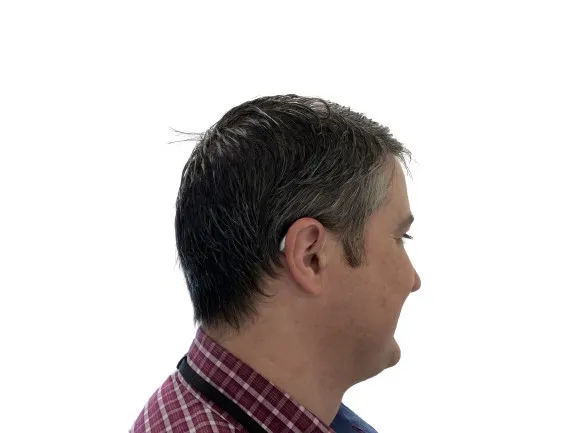What Are In-the-Ear (ITE) Hearing Aids?
In-the-Ear (ITE) hearing aids are custom-molded devices that fit directly into the ear canal and outer ear bowl. Because they sit inside the ear rather than behind it, they are often chosen for their discreet appearance and ease of handling. For individuals with dexterity issues, such as arthritis or tremors, ITE devices can be easier to insert and remove compared to tiny behind-the-ear models.
ITE hearing aids come in several subtypes, including:
- Invisible-in-Canal (IIC): Deeply inserted, nearly invisible.
- Completely-in-Canal (CIC): Very small, sitting fully in the ear canal.
- In-the-Canal (ITC): Slightly larger, partially filling the canal.
- Full Shell ITE: Larger, filling the entire outer ear bowl.
Each style offers different levels of visibility, battery size, control options, and comfort. You can read more about how these compare in my guide to hearing aid styles.
While the personalized fit is a key advantage, comfort varies widely depending on ear canal anatomy, venting, and how well the mold was made. This leads to one of the most common complaints from new wearers: the plugged-up sensation.
Why ITE Hearing Aids Can Feel Uncomfortable
Despite their convenience, many patients report that ITE hearing aids feel unnatural or even irritating during the adjustment period. The main reasons include:
1. The Occlusion Effect (Plugged-Up Feeling)
When the ear canal is sealed by a hearing aid shell, the user’s own voice often sounds boomy or echo-like. This “barrel” effect is known as occlusion.
- It occurs because low-frequency sounds (like your own voice or chewing) become trapped inside the sealed canal.
- Venting (small air holes in the mold) can reduce occlusion, but the size of the vent is limited by your hearing loss level and ear canal size.
👉 For a deeper dive into how the brain adapts to new sounds, see my article: How Many Hours a Day Should You Wear Hearing Aids?.
2. Ear Canal Anatomy
No two ear canals are the same.
- Narrow, sharply curved, or angled ear canals can cause friction and pressure points, making an otherwise well-fit ITE aid feel tight.
- Patients with small or sensitive ear canals may experience soreness after only a few hours of wear.
3. Wax Buildup and Hygiene
Because ITE aids sit directly inside the canal, they are more prone to earwax blockages.
- Wax buildup not only clogs the device but can also make it feel tighter or cause itching.
- Consistent cleaning and routine maintenance are crucial. For more tips, see my Complete Guide to Hearing Aid Maintenance & Repairs.
4. Skin Sensitivity
Some patients develop mild irritation from the acrylic or silicone material used in custom shells. This is rare but can usually be resolved by refinishing or remaking the earmold with a different coating.
5. Dexterity and Controls
While many people with tremors or arthritis find ITE aids easier to handle, others struggle with their tiny volume wheels or program buttons, which may require fine finger movements. This can lead to frustration and the perception that the device is “uncomfortable” to use.
RIC Hearing Aids: Comfort with Options
Receiver-in-Canal (RIC) hearing aids have become the industry standard in recent years, and for good reason. They combine the stability of a behind-the-ear design with the acoustic advantages of placing the receiver (speaker) inside the ear canal. This hybrid approach often results in a lighter, more comfortable fit than custom in-the-ear styles.
RIC hearing aids sit discreetly behind the ear with a thin wire leading into the ear canal, where the receiver is fitted with either a soft dome or a custom earmold. This design offers flexibility for different hearing losses and ear shapes.
Why RICs Are Often More Comfortable
- Lightweight design – The bulk of the electronics sits behind the ear, reducing pressure inside the canal.
- Ventilation options – Open domes allow airflow, helping to reduce the occlusion effect that many ITE wearers dislike.
- Easier cleaning – Since domes can be replaced and receivers are modular, RICs are less prone to complete clogging from wax.
- Adaptable fittings – Audiologists can quickly swap domes or molds during follow-ups to improve comfort.
👉 For a deeper breakdown of RIC hearing aids and how they compare to ITE, visit my Everything to Know About Hearing Aids hub page.
Domes vs. Earmolds: Which Is More Comfortable?
One of the main advantages of RIC hearing aids is the ability to choose between domes or custom earmolds. Both have pros and cons depending on your hearing needs, lifestyle, and comfort preferences.
| Feature | Domes | Earmolds |
|---|---|---|
| Material | Soft silicone tips (various sizes & shapes) | Custom-made from acrylic or silicone |
| Ventilation | Allows natural airflow → reduces occlusion | Can be made with large vents for comfort |
| Wax Management | Less prone to total blockage | More prone to clogging, but easier to clean thoroughly |
| Comfort Level | Light, flexible, and easy to adjust | Secure fit, better for active lifestyles or severe loss |
| Visibility | Nearly invisible | More visible, especially full shell styles |
| Best For | Mild to moderate losses, first-time wearers | Severe to profound losses, complex ear shapes |
Domes
Domes are popular with first-time users because they are soft, flexible, and minimally invasive. They allow natural sound to enter the ear alongside amplified sound, making speech and environmental sounds feel more natural. Some users notice a “tickling” sensation at first, but this usually resolves after a few weeks of consistent use.
Earmolds
Earmolds are custom-crafted from an impression of your ear canal. While they are slightly bulkier, they provide:
- Better sound quality for severe hearing loss.
- Secure retention, ideal for active users or those who wear glasses.
- Customizable venting, which can reduce occlusion more effectively than ITE aids.
Although earmolds are more visible than domes, many patients find them worth the trade-off for improved sound clarity and comfort.
👉 Pro tip: Most manufacturers (Oticon, ReSound, Phonak, etc.) allow you to trial both domes and earmolds during your fitting period, so you don’t have to commit before you know what’s comfortable.
2025 Top Picks for Comfort and Everyday Use
As an audiologist who has fitted thousands of patients, I’ve found that comfort is just as important as sound quality. Below are my top recommendations for 2025, based on real-world patient feedback, clinical performance, and comfort features.
Professionally Fit: Oticon Intent 1 miniRITE
- Design: Slim, lightweight behind-the-ear with a receiver in the canal.
- Comfort Factors: Available with both open domes and custom earmolds, allowing maximum flexibility for different ear canal shapes. The balance of weight behind the ear means very little pressure is felt inside the ear canal.
- Technology: Features Oticon’s BrainHearing™ technology, designed to reduce listening effort and improve clarity in noisy situations. Patients report that this leads to less fatigue during all-day wear.
- Best For: Patients with mild to severe losses who want all-day comfort combined with the most advanced sound processing available.
👉 Learn more about how professional fittings improve comfort in my Best Hearing Aid Recommendations Guide.
Over-the-Counter (OTC): Lexie B2 Powered by Bose
- Design: A discreet OTC receiver-in-canal device.
- Comfort Factors: Uses soft silicone domes, which make it lightweight and easy to adjust without a custom impression. Most users describe the fit as “barely noticeable” after the first week.
- Technology: Bose’s app-driven controls allow you to make personalized adjustments at home, which helps reduce discomfort from too much or too little amplification.
- Best For: Adults with mild to moderate hearing loss looking for a balance of affordability, comfort, and self-fit flexibility.
👉 For more on the OTC category, see my Complete Guide to OTC Hearing Aids.
Other Comfortable Options to Consider
- ReSound Nexia RIC – Known for soft-fit domes and a wide range of venting options.
- Phonak Infinio RIC – Secure earmold options for active users who need stability and clarity.
- Widex Moment Sheer – Unique ear-tip design that reduces the “plugged-up” sensation for new wearers.
By including multiple brands, you’ll be able to trial and compare—something I always recommend to patients. Comfort is highly individual, and no single model fits everyone.
Patient Story: From Discomfort to Comfort
“One of my patients initially chose in-the-ear hearing aids for their discreet look. However, she experienced constant echoing of her own voice and soreness in her ear canal. After discussing alternatives, we fit her with receiver-in-canal (RIC) hearing aids with open domes. Within two weeks, she reported the devices felt natural and she no longer noticed the ‘plugged-up’ sensation. This change allowed her to wear them all day without discomfort.”
Final Thoughts: Finding the Right Fit for Comfort
Choosing a comfortable hearing aid is more than just picking a style—it’s about working with your audiologist to find the right combination of device, fitting, and adjustments. Here are key takeaways:
- Comfort is Personal: What feels secure and natural for one person may feel tight or echoey for another. Trial periods are designed for this reason—don’t hesitate to ask for remakes, dome swaps, or vent adjustments.
- RICs Are Consistently the Most Comfortable: For most patients, receiver-in-canal designs strike the best balance of comfort, natural sound, and easy maintenance.
- Proper Fit Matters More Than Brand: Even the best hearing aid will feel uncomfortable if it isn’t properly fitted. That’s why professional fittings and follow-ups are crucial.
- Don’t Settle for Discomfort: Hearing aids are a long-term investment. If your ITE hearing aid feels uncomfortable, communicate openly with your audiologist. Small changes—like adjusting vent size, swapping to a dome, or refinishing a shell—can make a huge difference.
👉 If you’re starting your journey, I recommend reading Everything to Know About Hearing Aids for a complete overview before choosing a style.
Frequently Asked Questions About Hearing Aid Comfort
Do in-the-ear hearing aids hurt at first?
Some patients report mild discomfort or pressure when first wearing ITE hearing aids. This is usually due to the ear adjusting to having a device in the canal. Most discomfort resolves within 1–2 weeks, but if soreness continues, an audiologist can adjust venting, remake the shell, or recommend an alternative style.
How long does it take to get used to ITE hearing aids?
On average, it takes 2–4 weeks for the brain and ears to adapt to new ITE hearing aids. Consistent daily use is key. If occlusion or discomfort persists, adjustments can usually be made during the trial period.
Which hearing aid style is most comfortable for small ear canals?
For patients with small or narrow ear canals, receiver-in-canal (RIC) hearing aids with open domes are typically more comfortable than custom ITE devices. They apply less pressure inside the ear canal and allow better airflow, reducing the “plugged-up” feeling.

